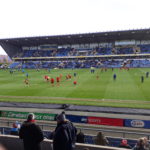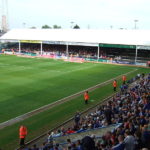It was on 18th June that I put up the first in this series, covering the League One clubs beginning A-L, apart from Bury, Blackpool and Bolton. This, part two, was intended to cover the back end of the alphabet but, at 2,300 words, ended up far too big for a single webpage.
There was only one answer. I had to split the piece and cover only five clubs, meaning there will be a part three for the last five and part four for the Lancashire Bs and Sunderland. These will arrive at some yet undetermined point in the future, bet you can’t wait.
MK Dons
The Dons were relegated from the championship in 2016 (along with Bolton and Charlton) and invested in players but failed to get promotion. Then they were relegated to League 2, where they stayed for 1 season, during which they had an operating loss of over £1 million. Net liabilities are in the region of £10 million. Their newly built (2007) stadium and hotel generate income streams for their parent company, who provide continuing finance.
Being new, their stadium (I’ve never been there) must be comfortable, have good sight lines etc, and be an attractive proposition for a match-goer. MK Dons are very involved with community activities and Milton Keynes itself has a population of over 200,000, is surrounded by motorways and has a main line railway running through it. It therefore comes as a bit of a surprise to find crowds haven’t changed much throughout their ups and downs. MK Dons sometimes topped 9,000 last season, which is about twice the average for League 2, but crowds were only in the 13,000s in their Championship season, when you could reasonably expect a bit more enthusiasm. “Scope for improvement” might be Pete Sixsmith’s verdict when in OFSTED mode. Alternatively, you could say they are developing a solid core of MK-based fans but have yet to attract those from their hinterland.
These figures lead me to expect crowds of 10-11,000 next season, which would not be bad for League One. Such figures will probably enable them to consolidate their place but not generate enough funds to support a strong challenge for promotion, so it’s over to the parent company…
Oxford United

Oxford experienced wholesale changes in 2018, following a takeover in which Oxford Investment Holding PTE Ltd, which is registered in Singapore and owned by Sumrith Thanakarnjanasuth (previously a director at Reading) replaced Ensco 1070. (I don’t know what that means, either). That accounting year the club made a £2 million operating loss and had liabilies in excess of £10 million. Loans of £3.5 million are indicated on a legal charge which was was placed on the club in 2018.
Oxford United have been subject to a few winding up petitions for non-payment of rent at the Kassam Stadium (one side says it’s £300,000 pa + service charges, the other says it has gone up from £500,000 to almost one million per season). The most recent was dismissed last month after rent of £204,000 was paid. No revenue streams come from the Kassam Stadium and with relations between the club and the stadium owner at an all time low the club apparently can’t even sell their shirt sponsor’s beer in the stadium during games. I’m not suggesting you’d want to drink it, it being Singha beer (i.e. lager) with very mixed reviews, but not being able to sell it strikes me as a bit mean-spirited. I bet Mr. Thanakarnjanasuth is peeved.
Without much in the way of alternative revenue streams apart from sponsorship and money from the owners attendance must be a prime source of income but the club doesn’t often get more than 7,ooo through the doors. Their biggest league crowd last season was 10,000, when they played us, but it’s more common to find the stadium (capacity 12,500) half empty.
The new owners are trying to rebuild the club’s relationship with Mr. Kassam. This might resolve the rent issue and without this and/or cash injections, which could be limited by FFP restrictions, it’s hard to see Oxford improving on the very creditable 12th place they managed last season.
Peterborough United

Posh are another club who don’t own their own ground, for which they pay rent of £380,000 pa ( subject to review). New directors bought 50% of the club in 2018 and the accounts for that year did not include a profit and loss statement, although the club historically run an operating loss of around £1.5 million per year unless they sell someone decent – which they have done quite often. They appear to have liabilities of around £10 million, much of which comprises loans from “entities with joint control over the company”, who charged commercial rates of interest until last year. New shareholders aside, they have had the same owner, Darragh Macanthony, since 2006 so the club does have stability.
I don’t suppose fans can complain about those entities as the most recent accounts also state “The company is reliant on the continuing support of its joint controlling companies, creditors and bankers to continue to trade.” While on the subject of fans, I don’t think there are all that many. The Peterborough Telegraph reported a rise in attendance last season but only to an average of 7,364. Even against us, on Easter Monday, they only managed 11,277. And this, you will remember, is the club that blazed a trail early in the season. They spent the first third of it in the automatic promotion spots and only finished one point behind Doncaster. Peterborough isn’t much smaller than Milton Keynes, and perhaps twice the size of Lincoln, who both get a lot more people through the gates.
Will Posh mount another challenge in 2019-20? There’s no reason why they shouldn’t – they are certainly a top-half club (9th in 2017-18) and the bookies have them at short odds for the top two – but I somehow don’t think they will; more because of their decline last season than anything else, but that low attendance figure doesn’t help their cause.
Portsmouth
There were wholesale changes in 2017 after American investment in the club provided a cash injection of £10 million, resulting in assets of 12.5 million being declared in 2017-18.

Following promotion from League two Pompey sold 14,600 season tickets – a bit different to Posh, Oxford and MK Dons, and gates increased, as you might expect. The club also saw other revenues increase and made a profit on transfers but ended the season with an operational loss of £1.3 million, though it does have some tax losses it can use to its advantage.
Fratton Park’s capacity is 21,000 and the club regularly gets gates of 18,000. Gate money and the recent inward investment mean the club will remain well able to mount a promotion challenge. The bookies think so, too, they’re among the favourites at 4/1 for a top two finish.
Rochdale
Rochdale are another club which has seen wholesale change at Board level in the past year. Chairman/President Andrew Kilpatrick gave this statement about it
Total income is around £5 million per year, with gate reciepts providing around £1 million and sponsorship another £0.5 million. According to Kieron Maguire (again) they had the lowest wages in division 1 at 68% of income.

Their stadium, Spotland, (naming rights have been sold and it now goes by the name of the Crown Oil Arena ) is owned by a subsidiary company which bought out Rochdale Hornets in 2016, and The Dale pay rent but get back more from their subsidiary than they pay. The ground hosted a game in the Rugby League World cup in 2013 and I presume Hornets also pay rent because they are still there, and this is the kind of thing that benefits the footballing side.
That’s just as well because Rochdale’s crowds are in the 3,500 range and some of League One’s lowest. Beset by attractions on every side, be it walking in the Pennines, watching Man City/United or Rugby League (although Hornets don’t pull in big crowds) that figure is unlikely to improve.
Rochdale have been in the Football League for nigh on a century and in League One for a few seasons now. They look likely to stay there, although they only stayed up this season by four points after sacking their manager. A local club for local people, with much to admire and an understanding of small club finances. There are worse descriptions.
That leaves Rotherham, Shrewsbury, Southend, Tranmere and Wycombe for part three, who will be followed by Blackpool, Bolton and Bury, along with Sunderland in part four of our League One journey. Keep an eye out for the next two posts the series, when I’ll be casting my beady eye their way.
